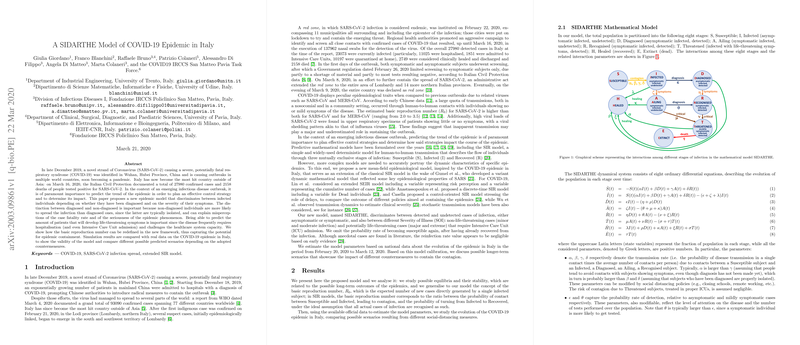Overview of the SIDARTHE Model for COVID-19 Epidemic in Italy
The paper "A SIDARTHE Model of COVID-19 Epidemic in Italy" proposes an advanced epidemiological model to track and predict the COVID-19 epidemic's trajectory in Italy. The SIDARTHE model is an extension of the classical SIR model, tailored to reflect the distinct characteristics of COVID-19 transmission and progression. This essay will provide a detailed summary of the paper, targeted at researchers familiar with epidemiological modeling.
Model Description and Innovations
The SIDARTHE model introduces several novel features to better capture the complexity of COVID-19 transmission and impact. Specifically, it subdivides the infected population into detected and undetected cases and categorizes them based on the severity of their symptoms. These compartments are:
- S (Susceptible)
- I (Infected undetected asymptomatic)
- D (Detected asymptomatic)
- A (Ailing undetected symptomatic)
- R (Recognized symptomatic detected)
- T (Threatened life-threatening detected)
- H (Healed)
- E (Extinct/dead)
The interactions among different stages of the infection are modeled using a set of differential equations. This allows for a more accurate depiction of the disease's dynamics, particularly in light of varying detection rates and the different clinical courses of the illness.
Key Findings
Modeling Accuracy
The authors validate the SIDARTHE model by fitting it to real data from the COVID-19 outbreak in Italy from February 20, 2020, to March 12, 2020. The model parameters are calibrated accordingly, and the model is shown to accurately track the epidemic's progression in the early stages. The fitting process highlights an important aspect: the number of infections is significantly underestimated due to a large fraction of undiagnosed cases, leading to a misperception of the epidemic's severity.
Basic Reproduction Number
The paper redefines the basic reproduction number within the SIDARTHE framework: where the parameters represent various transmission and progression rates through different states. This refined captures the potential for epidemic containment more precisely than in traditional models.
Simulation and Scenario Analysis
The paper explores several scenarios under different social-distancing measures:
- No Further Countermeasures: The model predicts a severe outbreak, with about 73% of the population infected and around 5.2% mortality. The peak of infections occurs at around 76 days from the start of the outbreak.
- Mild Social-Distancing Measures: This scenario assumes measures that reduce infection coefficients, resulting in a new of 1.13. While the peak is delayed and reduced in amplitude, it still results in substantial infection and mortality rates.
- Strong Social-Distancing Measures: Assuming stronger measures reduce to 0.787. The peak of the outbreak occurs earlier, and the total number of cases and deaths are significantly lower, showing the effectiveness of stringent interventions.
- Very Strong Social-Distancing Measures: This scenario reduces to 0.329. The infection peak occurs much earlier, and the total number of infected and deaths drop dramatically, underscoring the importance of early and aggressive containment measures.
Implications and Future Directions
The SIDARTHE model has several critical implications:
- Policy Implementation: It demonstrates that stringent social-distancing measures can significantly curtail the epidemic's severity and save lives.
- Healthcare Preparedness: The model's ability to predict ICU admissions and other critical metrics can assist healthcare systems in preparing for peak loads.
- Epidemiological Insights: Differentiating between detected and undetected cases provides a more accurate picture of the epidemic, informing better policy and public health strategies.
Potential for Future Research
Future research could extend the model to incorporate reinfection probabilities, adapt it for other countries with different demographics and healthcare systems, and include varying healthcare capabilities during peak times. Additionally, integrating data from evolving therapeutic and immunological interventions could dynamically adjust the model's parameters, providing real-time guidance for managing the pandemic.
Conclusion
The SIDARTHE model represents a significant advancement in epidemiological modeling for COVID-19 by addressing the complexities of disease detection and progression. The results underscore the necessity of robust social-distancing measures and enhance our understanding of the epidemic's true dynamics. This model could serve as a foundational tool for researchers and policymakers in controlling the ongoing pandemic and preparing for future outbreaks.
